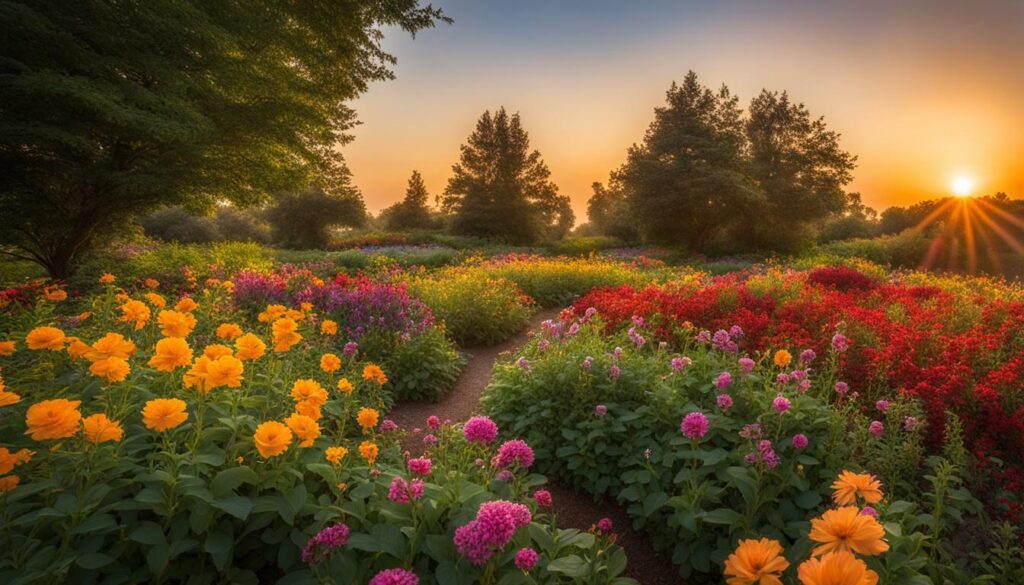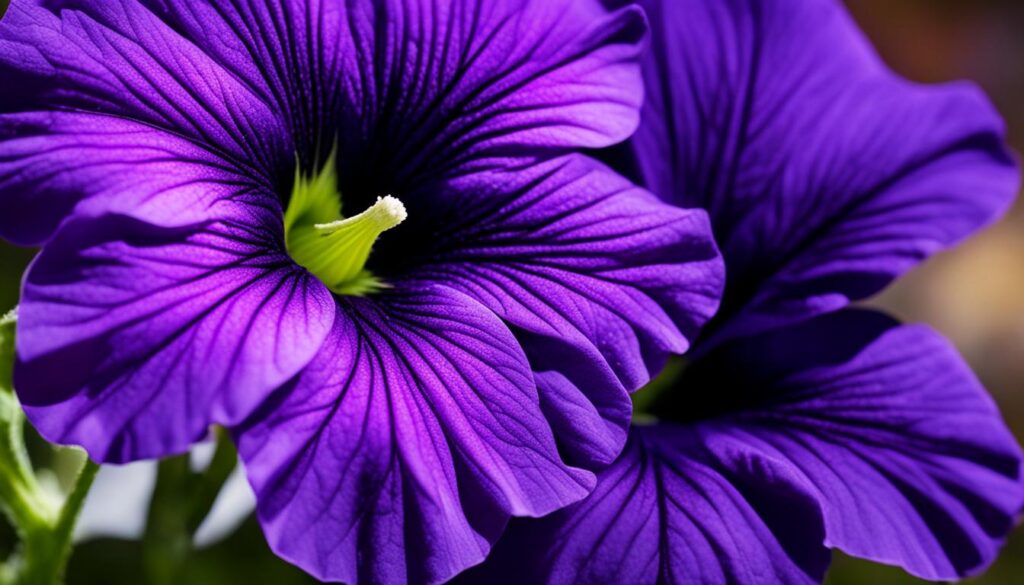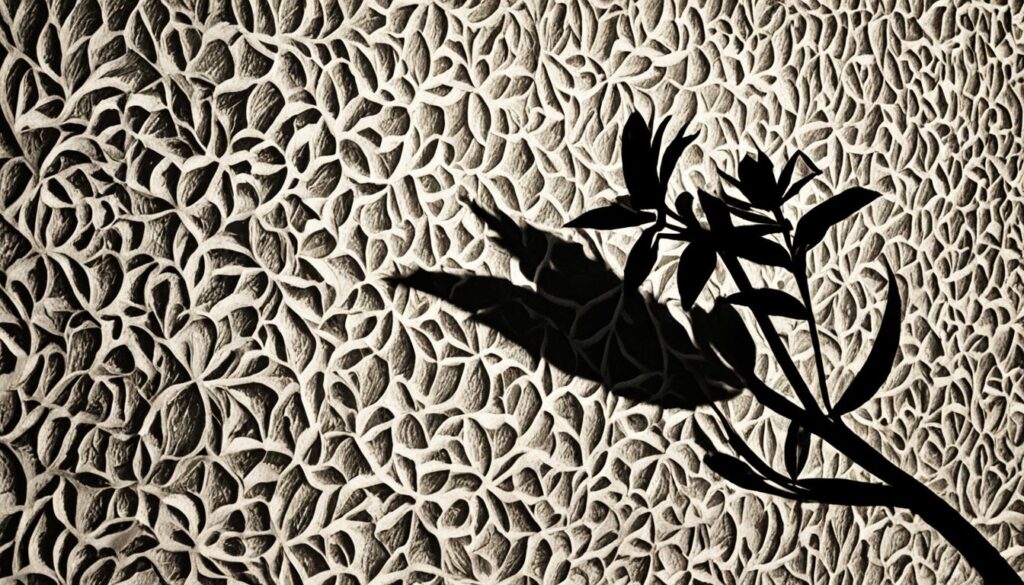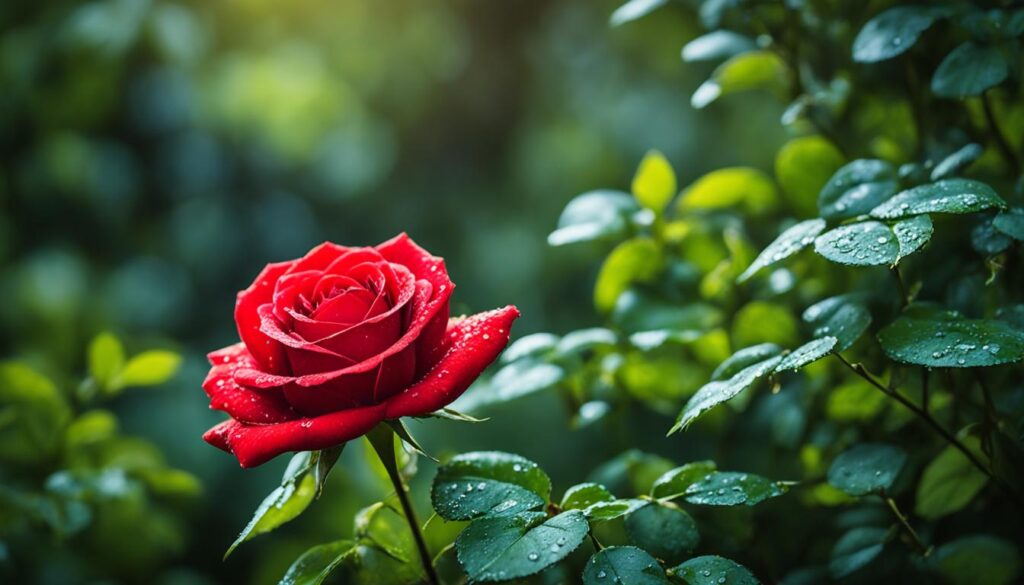Welcome to Garden Photography 101! I’m excited to share some essential tips and creative techniques that will help you capture the stunning beauty of your blooming garden through photography. Whether you’re a beginner or an experienced photographer, these tips will inspire you to create beautiful garden photos that truly capture the essence of your flowers.
From mastering macro photography to playing with colors and changing perspectives, there are endless possibilities to explore in garden photography. Let’s dive in and discover the secrets to capturing the captivating beauty of your garden blooms!
Key Takeaways:
- Capture the intricate details of your flowers with macro photography.
- Experiment with colors to create vibrant and captivating compositions.
- Change perspectives to breathe new life into your photos and avoid repetition.
- Tell a story through your flower photography by considering the surroundings and context.
- Choose the right gear and settings for optimal results in your garden photography.
Mastering Macro Photography
Macro photography is an essential technique for capturing the breathtaking beauty of flowers up close. It allows you to focus on the intricate details that often go unnoticed, revealing the hidden world within each petal and bloom. Whether you’re a beginner or an experienced photographer, mastering macro photography can significantly enhance your flower photography skills.
When it comes to macro photography, you don’t necessarily need an expensive macro lens to get started. Many kit lenses have a macro limit that allows you to get reasonably close to your subject. So, don’t worry if you don’t have a dedicated macro lens just yet. Instead, utilize the capabilities of your kit lens to practice and experiment with macro photography.
Getting up close to your subject is the key to capturing stunning close-up shots. By bringing your camera closer, you’ll be able to capture the details and textures that make each flower unique. Pay attention to the petals, the intricate patterns, and the delicate structures. The goal is to make the viewer feel like they can reach out and touch the subject.
“Macro photography allows us to explore the smallest details of nature, revealing the beauty that often goes unnoticed. It opens up a whole new world, captivating the viewer with its intricate patterns and textures.”
When shooting macro, it’s crucial to have a steady hand or use a tripod to eliminate camera shake. Even the slightest movements can result in blurry images, so make sure you’re stabilizing your camera properly. Additionally, consider adjusting your camera settings for macro photography. Use a smaller aperture (higher f-stop number) to increase the depth of field and ensure sharp focus throughout the subject.
Remember, practice makes perfect. Experiment with different flowers, angles, and lighting conditions to refine your macro photography skills. The more you explore this genre, the better you’ll become at capturing the enchanting details and unique beauty of flowers.
Playing With Colors
Colors are a vital element in the world of flower photography. They have the power to create captivating compositions and evoke different emotions. By harnessing the vibrant colors of flowers, you can elevate your floral photography to new heights. Let’s explore some techniques to play with colors and enhance the visual impact of your images.
Experiment with Color Theory
Color theory can be a valuable tool in creating visually striking photographs. One technique is to use complementary colors as a background for your flowers. Complementary colors are opposite each other on the color wheel, such as red and green or blue and orange. By incorporating these contrasting colors, you can create a dynamic and eye-catching composition.
Another approach is to fill the frame with analogous colors, which are neighboring hues on the color wheel. This technique lends a harmonious and dreamy atmosphere to your photos. For example, capturing flowers in different shades of pink and purple can create a soft and enchanting scene.
Changing Camera Position for Varied Backgrounds
Don’t limit yourself to capturing flowers from a single angle. By changing your camera position, you can add depth and variety to your compositions. Try shooting from below to feature the sky as the background, creating a sense of height and openness. Conversely, taking photos from above can showcase the ground as a textured backdrop, offering a unique perspective.
For even more versatility, consider carrying gradient background cards. These cards provide a quick and convenient way to create a background of your choice, adding an extra layer of creativity to your flower photography.
| Complementary Colors | Analogous Colors | Different Camera Positions |
|---|---|---|
| Red and Green | Shades of Pink and Purple | Shoot from Below |
| Blue and Orange | Yellow and Green | Shoot from Above |
| Purple and Yellow | Orange and Red |
Changing Perspectives
In flower photography, changing your perspective is crucial to avoid repetitive and monotonous shots. By experimenting with unique angles and viewpoints, you can bring a fresh and interesting perspective to your photos. While close-up shots are important for capturing the details of the flowers, don’t be afraid to step back and view them from different angles. This allows you to showcase the beauty of flowers through your own creative lens.
Imagine capturing a stunning bouquet of roses from above, with their vibrant colors arranged in a mesmerizing pattern. Or, get down on the ground and capture a patch of wildflowers from a low angle, highlighting their delicate petals against the backdrop of the sky. By varying your perspective, you can add depth and visual interest to your floral compositions.
To inspire your creativity, here are some tips to consider:
- Experiment with different angles: Instead of always shooting from eye level, try crouching down or standing on a higher platform to capture unique angles. This can create a more dynamic and visually appealing composition.
- Explore diverse compositions: Don’t limit yourself to centered shots. Play with asymmetry, leading lines, and negative space to create more interesting and balanced compositions.
- Look for creative viewpoints: Consider shooting through objects like fences, leaves, or even other flowers to add layers and depth to your photos. This can create a sense of mystery and intrigue.
- Get up close and personal: While stepping back can provide a broader perspective, don’t forget the beauty of macro photography. Capture the intricate details of a single petal or the fascinating patterns of flower stamens.
- Embrace the unconventional: Break free from traditional compositions and experiment with unconventional angles and viewpoints. Challenge yourself to capture the unexpected and showcase the uniqueness of each flower.
Remember, the beauty of floral photography lies in its ability to evoke emotions and captivate viewers. By changing your perspective and embracing creative viewpoints, you can create images that truly stand out and leave a lasting impression.
Tell a Story with Your Flower Photography
Flower photography is more than just capturing the beautiful flowers themselves; it’s about telling a story through your photos. By considering the context and surroundings of the flowers, you can add an extra dimension to your compositions and create meaningful narratives.
When taking flower photographs, pay attention to the environment, season, and location, as they can all contribute to the story you want to convey. Each element, whether it’s the abstract meanings associated with the flowers or the symmetries and patterns in their surroundings, adds depth to your composition.
To bring your story to life, widen your frame and include the surroundings in your photos. This will not only create more engaging and diverse compositions but also provide a broader context for your viewers to connect with. However, remember to keep the flowers as the main focus, ensuring they don’t get lost in the scenery.
Capturing the Environment
“The environment in which the flowers exist is just as important as the flowers themselves. It sets the stage and tells a rich story.” – Rachel Thompson
When photographing flowers, take a step back to capture the bigger picture. Include the landscape, the garden, or the natural surroundings to provide a sense of place and context. This approach not only creates visual interest but also conveys the relationship between the flowers and their environment.
Consider the season when showcasing the flowers in their natural habitat. Show the colorful blooms of spring, the lush greens of summer, the vibrant fall foliage, or the quiet beauty of winter gardens. By highlighting the changing seasons, you can elicit emotional responses and transport your viewers into the world of the flowers.
Abstract Meanings
“Flower photography is an opportunity to capture the abstract meanings that flowers represent. Every flower carries a story within itself.” – Sarah Miller
Flowers have symbolic meanings that can be translated visually in your photography. Explore the emotions and abstract concepts associated with different flowers and use them to infuse depth and narrative into your images. For example, a red rose represents love and passion, while a white lily symbolizes purity and innocence. Incorporating these meanings into your compositions can create a stronger visual impact.
Capturing Symmetries and Patterns
“Symmetries and patterns in nature are like the language of the universe. They resonate with us and evoke a sense of harmony.” – Mark Johnson
Patterns and symmetries can be found in nature, including the intricate designs of flower petals and the repetition of shapes and forms. Seek out these patterns and incorporate them into your compositions to create visually compelling images. Whether it’s the radial symmetry of a daisy or the spiral pattern of a sunflower, these visual elements enhance the storytelling aspect of your flower photography.

Using Flash for Flower Photography
When it comes to outdoor flower photography, lighting can sometimes be a challenge. That’s where flash photography can come in handy. By using flash, you can overcome shadows and add brightness to your images, especially on sunny days. This allows you to capture the true beauty of your flowers, even in less than ideal lighting conditions.
When using flash, you have control over the direction and intensity of the light. This gives you the ability to freeze the subject and use small apertures to capture all the intricate details of the flowers. However, it’s important to balance the flash with the natural lighting to achieve a natural-looking result.
One way to achieve this balance is by using diffusers to soften the light from the flash. This helps to eliminate harsh shadows and create a more even illumination. Additionally, adjusting your camera settings to balance ambient light with flash can also help create a seamless blend of natural and artificial light.
Experimenting with different flash techniques can further enhance your flower photos. You can try bouncing the flash off a nearby surface to create a softer, more diffused lighting effect. This can help create a more natural and flattering light on your subjects.
To give you a visual idea of how flash can impact your flower photography, take a look at the example below:
As you can see, using flash in flower photography can make a significant difference in the quality of your images. It helps to reveal more details and brings out the vibrant colors of the flowers.
So, don’t be afraid to experiment with flash to enhance your outdoor flower photography. With the right techniques and a good balance of natural and artificial light, your flower photos will truly shine.
Choosing the Right Gear for Flower Photography
When it comes to flower photography, having the right gear can make a significant difference in the quality of your photos. As a photographer, there are a few essential camera equipment and techniques you should consider for capturing the intricate beauty of flowers.
Macro Lenses for Close-Up Detail
A macro lens is a valuable tool for capturing the intricate details of flowers. These specialized lenses allow you to get up close to your subject and capture the tiny details that the naked eye might miss. With a macro lens, you can capture the beauty of delicate petals, the texture of leaves, or even the tiny droplets of water on the surface of the flowers.

Controlling Depth of Field with Aperture Priority Mode
Aperture priority mode is a useful setting for flower photography. It allows you to have control over the depth of field, which determines how much of the image is in focus. By adjusting the aperture settings, you can create a shallow depth of field, blurring the background and drawing attention to the main subject, or a deep depth of field, where both the foreground and background are in focus.
Finding the Right Balance: Shutter Speed and ISO
When photographing flowers, it’s important to find the right balance between shutter speed and ISO settings. Shutter speed determines how long the camera’s sensor is exposed to light, while ISO controls the sensitivity of the camera’s sensor to light. A faster shutter speed can help freeze the motion of flowers on a windy day, while a low ISO setting can reduce noise and ensure sharp and well-exposed images.
Handholding Techniques for Stability
To capture crisp and clear photos, it’s crucial to practice proper handholding techniques. Holding the camera steady is essential to avoid camera shake, which can result in blurry images. Make sure to hold the camera with both hands, tuck your elbows close to your body, and exhale gently as you press the shutter button. Consider using a tripod or other stabilizing equipment for more control and stability if needed.
With the right photography gear and techniques, you’ll be able to capture the delicate beauty of flowers with stunning detail and clarity. So, grab your camera, equip yourself with a macro lens, and get ready to explore the enchanting world of flower photography!
Capturing Details and Textures in Macro Flower Photography
Macro flower photography is a fascinating technique that allows you to capture the intricate details and textures of flowers up close. It provides a unique opportunity to delve into the mesmerizing beauty of petals, the delicate patterns, and the captivating essence of pollens. To capture stunning macro shots that showcase the true essence of flowers, try incorporating the following techniques:
Focus on the Details
When capturing macro shots, pay attention to the details and textures of the flower. Look closely at the intricate ribs on the petals, the fine dusting of pollen, and the delicate textures that make each flower unique. Adjust your camera settings and focus carefully to ensure that these details are sharp and well-defined in your frame. This will help you create visually striking images that portray the beauty of flowers in remarkable detail.
Experiment with Focusing Techniques
Experimenting with different focusing techniques can add depth and dimension to your macro flower photography. Try using a shallow depth of field to create a dreamy effect, where the focused area stands out while the rest gently fades into a soft blur. Alternatively, a larger depth of field can showcase the intricate details of the entire flower. Play around with different apertures and explore the creative possibilities that different focusing techniques offer.
Create Frame Composition
Frame composition plays a vital role in macro flower photography. Experiment with different angles, perspectives, and compositions to highlight the details and textures of the flower effectively. Try capturing the flower from various angles, such as top-down, side-on, or even from underneath to bring a unique visual perspective to your images. Pay attention to the natural lines and patterns within the flower and use them to guide your composition. Frame your shot in a way that draws attention to the intricate details, ensuring that they become the center of focus.
Visually Appealing Table:
| Technique | Description |
|---|---|
| Focus on the Details | Capture the intricate ribs, pollen, and textures of the flower |
| Experiment with Focusing Techniques | Try different depths of field to create varied effects |
| Create Frame Composition | Use angles, perspectives, and natural lines to highlight details |
By implementing these techniques, you can elevate your macro flower photography and capture stunning images that showcase the beauty of flowers in incredible detail. Whether it’s the delicate textures, the intricate patterns, or the captivating presence of pollens, macro flower photography allows you to explore the hidden world within each flower, creating visually captivating and breathtaking photographs.
Overcoming Challenges in Flower Photography
Flower photography can present unique challenges that photographers need to overcome in order to capture stunning images. From dealing with harsh shadows to unpredictable winds and direct sunlight, these obstacles can test our skills and patience. However, with a few techniques and a little creativity, it’s possible to overcome these challenges and achieve great results.
Shooting in Diffused Lighting
One of the ways to tackle difficult lighting conditions, such as harsh shadows and direct sunlight, is by shooting during diffused lighting situations. Cloudy days or the golden hour (the hour after sunrise or before sunset) provide soft, even lighting that can help eliminate harsh shadows and create a more pleasing look for your flower photographs.
Using Natural Elements and Reflectors
When faced with direct sunlight, you can use natural elements like leaves or reflectors to block the sun and soften shadows on your subject. By strategically positioning these elements, you can manipulate the light and create a more balanced exposure for your flower photographs.
Ensuring Camera Stability
Camera stability is crucial, especially when shooting in difficult lighting conditions or capturing details in macro photography. To prevent camera shake and ensure sharp images, consider using a tripod or stabilizing your camera with a bean bag or other support. This will help you maintain camera stability and achieve better results, particularly in low-light situations.
Implementing Noise Reduction Techniques
High ISO settings are often necessary in low-light situations, which can introduce noise into your images. To minimize noise and preserve image quality, it’s important to use noise reduction techniques during post-processing. However, it’s essential to strike a balance and avoid excessive noise reduction that could result in loss of detail or a softening effect.

Remember, every challenge presents an opportunity for creativity and experimentation. By applying these techniques and adapting to various lighting and environmental conditions, you’ll be able to capture the beauty of flowers in any situation.
Exploring Unique Perspectives in Garden Photography
In garden photography, there are limitless possibilities to capture unique perspectives and compositions that truly showcase the beauty of nature. By experimenting with different angles, symmetries, patterns, and framing techniques, you can create visually stunning and creative compositions that stand out.
One of the key aspects of garden photography is capturing unique angles that offer a fresh and captivating viewpoint. Instead of the usual top-down or eye-level shots, try getting down low or shooting from above to add a unique perspective to your photos. This can create interesting compositions and draw the viewer’s attention to details they may have otherwise missed.
| Techniques for Exploring Unique Perspectives | Examples |
|---|---|
| Shoot from ground level | |
| Experiment with high-angle shots | |
| Look for natural frames |
Another technique to consider is capturing symmetries and patterns found in gardens. Look for naturally occurring symmetrical elements, such as rows of flowers or the pattern of petals, and use them to create visually balanced and pleasing compositions. These symmetries can add a sense of harmony and order to your photos.
Framing techniques can also enhance the visual impact of your garden photography. Experiment with framing your subject within natural elements, such as archways, tree branches, or blooming vines. This can add depth and context to your photos, creating a sense of immersion and drawing the viewer’s eye to the main subject.
Finally, don’t be afraid to let your creativity shine through your compositions. Think outside the box and explore unconventional compositions that challenge the traditional norms. Embrace different perspectives, angles, and framing techniques to create unique and visually striking garden photographs that tell a story.
Tips for Photographing Flowers in Different Seasons
Each season presents a unique opportunity to capture the beauty of flowers through photography. From the vibrant blooms of spring to the colorful foliage of fall, each season offers its own distinctive charm. In this section, I will share some tips to help you make the most of each season and create captivating images that reflect the spirit of the time.
Spring Flowers: A Burst of Color
Spring is a magical time for flower photography, with an explosion of colorful blooms. To capture the essence of this season, get up close and focus on the intricate details of each flower. Experiment with different angles and perspectives to showcase their delicate beauty. Don’t forget to take advantage of the soft, diffused light that often accompanies springtime. This can help to enhance the colors and create a dreamy atmosphere in your photos.
Summer Blooms: Full Glory on Display
In summer, flowers are at their peak, displaying their full glory. When photographing flowers during this season, utilize the vibrant natural light to capture the rich colors and textures. Look for interesting compositions and experiment with capturing flowers in different environments, such as gardens or wildflower fields. Summer also offers the opportunity to include other elements, like butterflies or bees, that add life to your images.
Fall Foliage: Vibrant Backdrop
The fall season brings a stunning display of vibrant foliage, providing a beautiful backdrop for flower photography. Incorporate the changing colors of leaves into your compositions to create visually striking images. Look for contrasting hues and experiment with different perspectives to capture the essence of autumn. Keep in mind that soft, warm light can further enhance the beauty of fall flowers and foliage.
Winter Gardens: A Different Kind of Beauty
While winter may seem devoid of colorful blooms, there is still a unique beauty to be found in winter gardens. Look for flowers that bloom during this season, such as winter roses or camellias, and capture their delicate charm. When photographing winter flowers, pay attention to their textures and the way they interact with the snowy or frosty surroundings. Utilize natural light or experiment with low-light techniques to create a cozy and ethereal atmosphere in your photos.
By understanding and embracing the beauty of each season, you can create captivating flower photographs that evoke the spirit of nature’s ever-changing colors and landscapes.

Conclusion
As we conclude this Garden Photography 101 guide, I hope that you have gained valuable insights and techniques to capture the beauty of blooms in your own garden. By mastering macro photography, experimenting with colors and perspectives, and telling stories through your photos, you can create stunning images that truly showcase the essence of your garden.
Remember to embrace the challenges that come with flower photography and to let your creativity flourish. By trying different perspectives and compositions, you can capture unique and captivating shots that will leave a lasting impression. Don’t be afraid to think outside the box and let your love for photography guide your artistic choices.
With the tips and techniques shared by experts, capturing the beauty of blooms is within your reach. Take your camera, step into your garden, and let your passion for garden photography guide you in creating breathtaking images that celebrate the wonders of nature. Happy clicking!
FAQ
What is macro photography?
Macro photography is a technique that involves getting up close to your subject and capturing the intricate details that are often overlooked. It is particularly useful in flower photography to capture the small details and textures of flowers.
Do I need a dedicated macro lens for flower photography?
While dedicated macro lenses are available in the market, they are not necessary for beginners. Most kit lenses have a macro limit that allows you to get fairly close to the subject. The key is to practice and learn more about your camera and the type of photographer you are.
How can I play with colors in flower photography?
You can experiment with different color theories to create captivating compositions. Use vibrant colors of the flowers to create a visually appealing image. Try using complementary colors as a background or filling the frame with analogous colors to create a dreamy atmosphere.
How can I change perspectives in flower photography?
Changing your perspective is essential to avoid repetitive shots. Experiment with unique angles and viewpoints to bring a fresh and interesting perspective to your photos. Don’t be afraid to step back and capture the flowers from different angles to showcase their beauty.
How can I tell a story through flower photography?
Consider capturing the surroundings of the flowers to add a new dimension to your compositions. The environment, season, location, and abstract meanings can all contribute to creating a narrative in your photos. Include the surroundings in your frame to create engaging and diverse compositions.
How can flash be useful in outdoor flower photography?
Flash can help overcome challenging lighting conditions by brightening up the scene and eliminating shadows. It allows you to freeze the subject, use small apertures, and control the direction and intensity of the light. Use flash with diffusers to achieve natural-looking results.
What gear do I need for flower photography?
A macro lens is particularly useful for capturing the intricate details of flowers. In aperture priority mode, adjust the depth of field by setting the aperture. Practice proper handholding techniques to eliminate camera shake and ensure sharp photos.
How can I capture the details and textures in macro flower photography?
Focus on the details such as the ribs, pollen, and textures of the petals. Experiment with different focusing techniques to ensure the desired elements are sharp in your frame. Frame your composition creatively to highlight the intricate details of the flower.
What are some challenges in flower photography and how to overcome them?
Harsh shadows, wind, and direct sunlight are common challenges in flower photography. Overcome them by shooting in diffused lighting, using natural elements to block sunlight, and stabilizing your camera. Additionally, use noise reduction techniques to minimize noise in high ISO shots.
How can I explore unique perspectives in garden photography?
Look for interesting angles and viewpoints that showcase the symmetries and patterns found in gardens. Experiment with framing techniques to create visually striking compositions. Think outside the box and let your creativity shine through your photos.
How can I capture flowers in different seasons?
Each season offers unique opportunities for flower photography. Take advantage of the changing colors and seasonal backgrounds to create captivating photos. Capture the burst of colorful blooms in spring, the full glory of flowers in summer, the vibrant fall foliage, and the beauty of winter gardens.
How can I make my garden photos stand out?
Master techniques such as macro photography, utilize color theory, change perspectives, and tell stories through your photos. Embrace challenges, experiment with different perspectives, and let your creativity flourish. With practice and these tips and techniques, your garden photos will showcase the beauty of your blooms.

